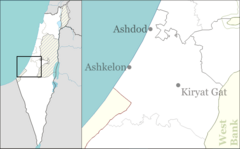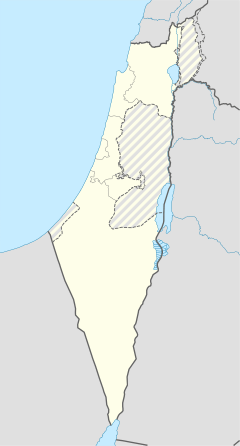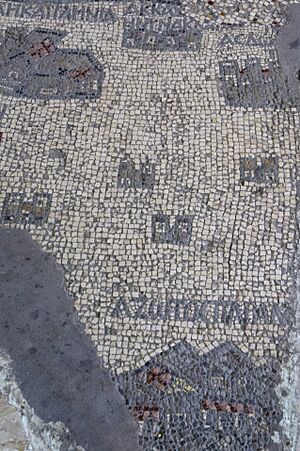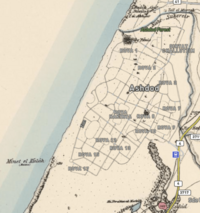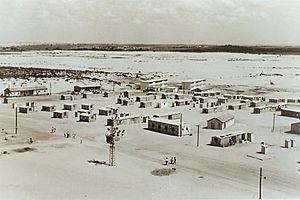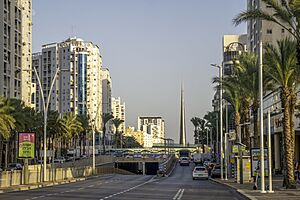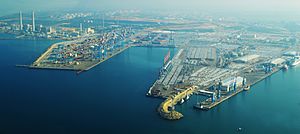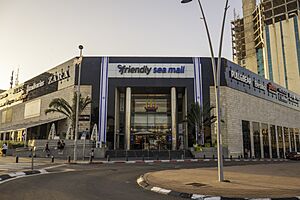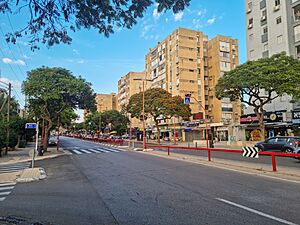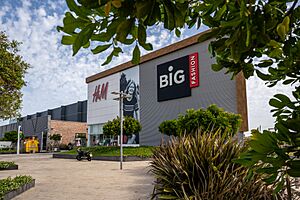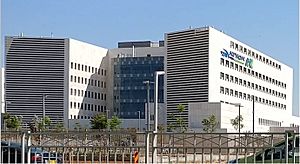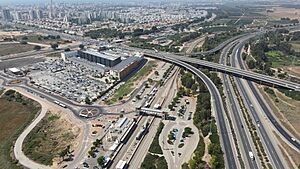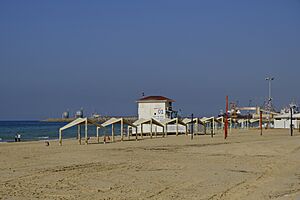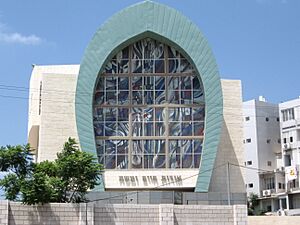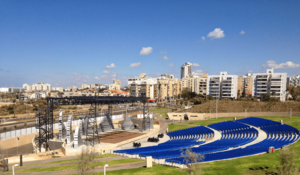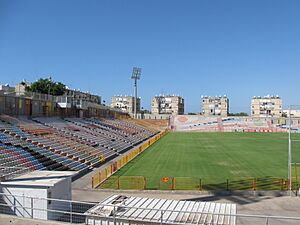Ashdod facts for kids
Quick facts for kids
Ashdod
|
||
|---|---|---|
|
City (from 1968)
|
||
| Hebrew transcription(s) | ||
| • ISO 259 | ʔašdod | |

From top left: Minat al-Qal'a, Cultural Center, Aerial view of the port, View of the marina, Square of Candles, Ashdod at night, Big Fashion Store, Sculpture The eye of the sun.
|
||
|
||
| Country | ||
| District | Southern | |
| Founded | 1956 (Israeli city) | |
| Area | ||
| • Total | 47,242 dunams (47.242 km2 or 18.240 sq mi) | |
| Population
(2022)
|
||
| • Total | 222,883 | |
| Website | www.ashdod.muni.il | |
Ashdod is the sixth-largest city in Israel. It is located in the country's Southern District. The city sits on the Mediterranean coast. It is about 32 kilometers (20 miles) south of Tel Aviv. Ashdod is also 20 kilometers (12 miles) north of Ashkelon.
Ashdod has a very long history, going back about 3,700 years. In ancient times, it was one of the five main cities of the Philistines. The modern city of Ashdod was started in 1956. It was built on sand dunes, about 6 kilometers (4 miles) northwest of the old city site.
Ashdod became an official city in 1968. It covers an area of about 60 square kilometers (23 square miles). Ashdod is a planned city. This means its growth followed a careful design. This design helps with traffic and keeps the air clean in living areas.
The city's port is the biggest in Israel. It handles 60% of all goods brought into the country. Ashdod is also an important industrial center. Dr. Yehiel Lasri has been the mayor since 2008.
Since it was founded, Ashdod has welcomed many Jewish immigrants. These people came from all over the world. This makes Ashdod a city with a very high number of new immigrants in Israel. It is home to the largest Moroccan and Karaite Jewish communities in Israel. It also has the biggest Georgian Jewish community in the world.
Contents
History of Ashdod
Ashdod has a rich history that spans thousands of years. From ancient settlements to its modern founding, the city has seen many changes.
Ancient Ashdod and Ashdod-Yam
The original town of Ashdod, now called Tel Ashdod, was about 6 kilometers (4 miles) southeast of today's city center. It began around 1700 BCE. It was a major Philistine city. It was one of the five main Philistine city-states.
There was also a separate coastal city called Ashdod-Yam. This city was southwest of modern Ashdod. It was important for trade.
The first city at Tel Ashdod was a strong Canaanite city. It was destroyed around the end of the Late Bronze Age. During the Iron Age, it became a powerful Philistine city. The Hebrew Bible mentions it 13 times.
Later, it was ruled by the Kingdom of Judah and then the Assyrians. Under Greek rule, it was known as Azotus. It then became part of the Hasmonean kingdom. In the 1st century BCE, it joined the Roman Empire.
During Byzantine times, Ashdod was a religious center. But its importance slowly faded. By the Middle Ages, it was just a village.
Ashdod-Yam, or Azotus Paralios, also started in the Bronze Age. It grew more important over time. In the Byzantine period, the coastal town became more important than the inland city. A fort called "Minat al-Qal'a" was built there by the Umayyad Caliph Abd al-Malik. This fort was rebuilt by later rulers. The port city stopped being mentioned later, likely destroyed to prevent its use by invaders.
Isdud Before 1948
Before 1948, there was an Arab town called Isdud. It was meant to be part of an Arab Palestinian state. But during the 1948 Arab–Israeli War, most of its residents left.
Founding Modern Ashdod
The modern city of Ashdod was founded on May 1, 1956. Levi Eshkol, who was the finance minister, approved its creation. The "Ashdod Company Ltd." was set up to build the city.
The first people to settle there were 22 families from Morocco. They arrived in November 1956. Then, more immigrants came from Egypt.
In 1957, the government gave land to the Ashdod Company Ltd. This land was for building the new city. The Eshkol A power station was finished in 1958. It helped provide power to the growing city.
A businessman named Israel Rogosin invested a lot in the city. He opened his main factory in Ashdod in 1960. He also funded high schools there. A main street in Ashdod is named after him.
The first local government was set up in 1959. By 1961, Ashdod had 4,600 people. Building the port started in 1961. It opened in 1963 and was first used in 1965.
The city grew steadily. New neighborhoods were built in the 1960s, 70s, and 80s. By 1972, the population was 40,300. It reached 65,700 by 1983.
Ashdod grew very fast starting in 1991. Many immigrants arrived from the Soviet Union and Ethiopia. The city's population grew by 150% from 1990 to 2001. More neighborhoods and a business district were built. Ashdod won the Education Prize in 2012 from the Israel Ministry of Education.
City Planning and Growth
Ashdod was built as a carefully planned city. This helped it grow in an organized way.
Urban Development Plan
The modern city was built on new land, away from the old historical site. The city was divided into seventeen neighborhoods. Each neighborhood was designed for 10,000 to 15,000 people.
Wide roads connect the neighborhoods. This helps traffic move easily. Each neighborhood has its own shopping center, urban park, and places for health and education. A central business area was also planned and built later.
Three industrial zones were placed near the port in the northern part of the city. They were located there because of the wind patterns. This helps keep air pollution away from where people live.
The city was planned for up to 250,000 residents. An extra area in the south was set aside for future growth. In 2012, a plan was approved to build a high-tech industrial park near the train station. The Port of Ashdod is also being greatly expanded.
Geography and Climate
Ashdod is located on the coast of Israel. It has a typical Mediterranean climate.
Natural Features
The Ashdod-Nitzanim sand dune nature reserve is a 20-kilometer (12-mile) stretch of sand dunes. It is located on the southern edge of Ashdod. This area is preserved as a nature reserve.
Weather in Ashdod
Ashdod has a Mediterranean climate. This means it has hot summers and cool, rainy winters. Since it's a coastal city, the air is often humid. Rain mostly falls from November to March.
In winter, temperatures rarely drop below 5°C (41°F). They are usually between 10°C and 15°C (50-59°F). In summer, the average temperature is about 27°C (81°F). The city gets about 510 millimeters (20 inches) of rain each year.
Economy and Business
Ashdod is a very important center for industry in Israel. Its port plays a huge role in the country's economy.
Industrial Centers
All of Ashdod's industrial activities are in the northern parts of the city. These areas include the port and the northern industrial zone. The Port of Ashdod is the largest port in Israel. It handles about 60% of all cargo coming into the country. The port has been updated to handle very large ships. Many shipping companies have offices in the port area. There is also a power station and a coal terminal here.
The Northern industrial zone is located along Highway 41. It has different types of industries. This includes an oil refinery, one of only two in Israel. The heavy industry zone is south of the Lachish River. It used to be the main industrial area. Now, it also has places for fun and entertainment. Some industries still operate here, like a Teva Pharmaceutical Industries plant. Elta, a part of Israel Aerospace Industries, is also in Ashdod. They develop radar and electronic systems.
Shopping and Fun
Ashdod has many places for shopping and entertainment. Each neighborhood used to have its own small shops.
Retail and Entertainment Venues
In the 1990s, shopping malls became popular in Israel. Ashdod's main shopping moved to these malls. The first mall was the Forum Center. It now mainly has offices.
Lev Ashdod Mall opened in 1993 and has been expanded. Ashdod Mall, which opened in 1995, has also been redesigned. City Mall, Ashdod opened in 1996. It is connected to the central bus station. The Sea Mall has three floors, a climbing wall, and a movie theater. Star Center also doubled in size in 2007.
Education and Learning
Ashdod places a high value on education. The city has many schools for its young residents.
School System
In 2013, Ashdod had 500 schools. These schools employed 3,500 teachers. The total number of students was 55,000. The city's budget for education was NIS 418 million shekels.
Lycée français Guivat-Washington is a French international high school. It is located near Ashdod in Givat Washington.
Healthcare Services
Ashdod has modern healthcare facilities to serve its residents.
Hospitals and Clinics
Assuta Ashdod Medical Center is Ashdod's only general hospital. It serves the city and nearby areas. It is a 300-bed hospital. Its special design helps it keep working even during wartime. It is also a university hospital connected to Ben-Gurion University of the Negev. The hospital opened in 2017. Before it opened, people had to travel to other cities for hospital care.
There are also public and private clinics in the city. A special clinic run by Hatzalah operates when other clinics are closed.
Transportation in Ashdod
Ashdod has a well-developed transportation system. This includes roads, trains, and buses.
Road Network
Ashdod is on the historic Via Maris route. Highway 4 is a main road that follows this route. It connects Ashdod to the Tel Aviv area in the north and Ashkelon in the south. The Ad Halom junction is the main entry point to the city from the east.
The Ashdod Interchange opened in 2009. It made Highway 4 a freeway in this area. Highway 41 is another important road. It runs from west to east towards Gedera. This road is the main link to the Port of Ashdod and industrial zones.
In 2012, Ashdod received a grant to improve public transportation. This included creating special bus lanes on main roads. It also involved building a BRT system and smart bus stops. The first stage of this plan, called 'Reway', was finished in 2019. The second stage was completed in 2022.
Train Services
Passenger train service to Ashdod started in 1992. This was after the old railway to Egypt was updated. The Ashdod railway station is on Israel Railways' Binyamina/Netanya – Tel Aviv – Ashkelon line. It is near the Ad Halom Junction. The station was upgraded in 2003 with a new building. A new road to the station opened in 2008.
There is also a lot of freight train traffic in the area. The Port of Ashdod has its own railway lines. It also has a special terminal for potash brought from the Sodom area for export.
Bus Services
A new central bus station opened in 1996. It is a main stop for both city and intercity buses. The central bus station is connected to the City Mall. Intercity bus lines connect Ashdod to most major towns in central and southern Israel.
| Company name | Major destinations |
|---|---|
| Egged | Jerusalem, a seasonal line to Eilat |
| Metropoline | Be'er Sheva, Kiryat Gat, Sderot, Netivot |
| Electra Afikim | Tel Aviv (CBS and Arlozorov Terminal), Bar Ilan University, Tel HaShomer, Rishon LeTziyon, Rehovot, Yavne, Ashkelon, Kiryat Mal'akhi, Gedera, Gan Yavne |
| Electra Afikim | Intracity service |
Sea Travel
There is a passenger pier at the Port of Ashdod. More and more people are using it, especially for cruise ship trips. The Blue Marina is another place for boats and yachts.
People and Culture
Ashdod is a diverse city with a growing population. It is known for welcoming people from many different backgrounds.
Population and Demographics
| Historical population | ||
|---|---|---|
| Year | Pop. | ±% p.a. |
| 1961 | 4,600 | — |
| 1972 | 40,300 | +21.81% |
| 1983 | 65,700 | +4.54% |
| 1990 | 83,900 | +3.55% |
| 1995 | 125,820 | +8.44% |
| 1996 | 137,100 | +8.97% |
| 2000 | 174,224 | +6.17% |
| 2001 | 187,000 | +7.33% |
| 2003 | 192,200 | +1.38% |
| 2006 | 204,400 | +2.07% |
| 2008 | 209,200 | +1.17% |
| 2016 | 220,883 | +0.68% |
Sources:
|
||
Ashdod is the sixth largest city in Israel. Its population is growing by about 2.6% each year. The city has a younger population compared to the rest of Israel. This is because many young couples live there.
Welcoming Immigrants
Ashdod has grown a lot by welcoming immigrants. The first settlers were Jewish immigrants from Morocco and Egypt. In the 1960s, many people came from Romania. In the 1970s, many arrived from Georgia.
More than 60,000 Russian Jews from the former Soviet Union settled in Ashdod in the 1990s. About 32% of the city's population are new immigrants. Most of them are from the former Soviet Union. In the 1990s, many Beta Israel immigrants from Ethiopia also came. More recently, people have moved to Ashdod from the United States, United Kingdom, France, Argentina, and South Africa. Many Bene Israel from Maharashtra, India have also settled here.
Religious Life
Over 95% of Ashdod's population is Jewish. The city has many synagogues for different Jewish groups. Ashdod is also home to the world's largest Karaite community, with about five thousand members. There is also a Scandinavian Seamen Protestant church.
Arts and Entertainment
Ashdod is a lively city with a rich cultural scene. It offers many opportunities for music, art, and performances.
Music and Performing Arts
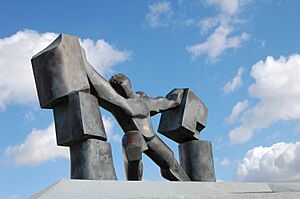
Ashdod is home to the Israeli Andalusian Orchestra. This orchestra plays Andalusian classical music. This style of Arabic music comes from ancient Spain. The orchestra won the Israel Prize in 2006.
Ashdod also has one of the biggest outdoor theaters in Israel, called Amphi Ashdod. It can hold over 6,400 people. The Amphi hosts Ashdod's international art festival, "Méditerranée".
The MonArt Centre for the Arts is a major performing arts center. It has a ballet school, a music center, and the Ashdod Museum of Art. This impressive building opened in 2003. Plays and concerts are held in several places. The most important shows are at the Ashdod Performing Arts Center. This new concert hall opened in 2012. Ashdod also hosts many music festivals, like the annual Super Jazz Ashdod Festival.
The ACADMA conservatory is a professional music school in Ashdod. It teaches about 600 young musicians.
Museums to Explore
The Corinne Mamane Museum of Philistine Culture is the only museum in the world dedicated to this topic. It reopened in 2014 with new exhibits. The museum displays important Philistine items from their five main cities.
The Ashdod Museum of Art is located in the MonArt center. It has 12 galleries and two exhibition halls. The entrance to the museum is through a glass pyramid, similar to the Louvre in Paris.
Sports and Recreation
Ashdod offers many sports activities and has several successful teams.
Sports Teams and Venues
Ashdod's football team, F.C. Ironi Ashdod, plays in the Israeli Premier League. The club is known for its strong football school. Hapoel Ashdod F.C. also plays in the city. The top basketball team is Maccabi Ashdod. Their men's team plays in Israel's top league. The women's team, Maccabi Bnot Ashdod, also plays in the top division.
Ashdod hosts many national and international sports events. This includes the yearly Ashdod International Chess Festival. The city even has a cricket team, which is rare in Israel. It is run by people of Indian descent.
Water Sports
Ashdod's beaches are great for water sports. You can enjoy windsurfing and Scuba diving there. The Ashdod Marina offers services for yachts and boats.
Famous Athletes from Ashdod
- Vered Borochovsky – Swimmer in the 2000 Sydney and 2004 Summer Olympics.
- Alon Day – Professional race car driver.
- Alon Hazan – International soccer player.
- Haim Revivo – International soccer player.
Sister Cities
Ashdod is connected with many cities around the world. These are called twin towns or sister cities.
|
|
Notable People
- Ofir Ben Shitrit (born 1995), singer
- Nir Bitton (born 1991), footballer
- Alon Day (born 1991), racing driver
- Igor Olshanetskyi (born 1986), Olympic weightlifter
- Valery Panov (born 1938), dancer and choreographer
- Dorit Revelis (born 2001), model
- Haim Revivo (born 1972), footballer
- Anna Zak (born 2001), social media star
Past Notable Residents
- Georgy Adelson-Velsky lived in Ashdod from 1992 until his death in 2014.
Images for kids
See also
 In Spanish: Asdod para niños
In Spanish: Asdod para niños



